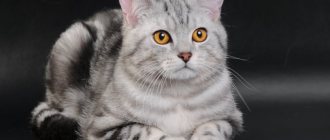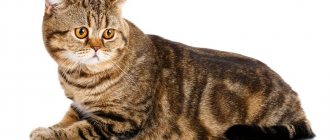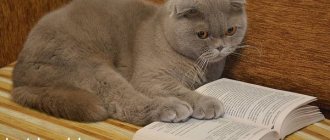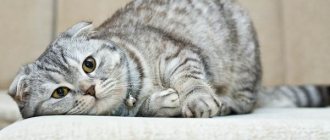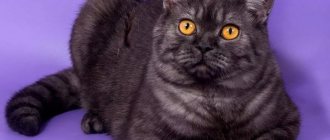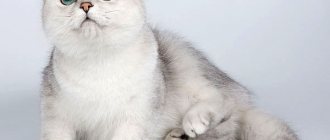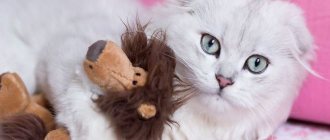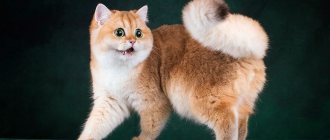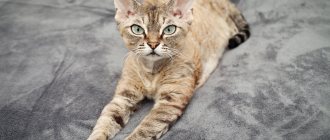The Scottish Straight is a Scottish straight-eared cat, one of the varieties of the Scottish breed, the distinctive features of which are: short plush hair and erect ears. Hence the explanation of how Scottish straight is translated: in English it is scottish straight, translation into Russian is “Scottish” + “straight”. In total, there are four varieties of Scottish cats: Scottish Straight, Scottish Fold (short-haired fold), Highland Straight (semi-long-haired straight-eared) and Highland Fold (semi-long-haired fold). Each of them has its own appearance characteristics.
Article continues after advertisement
History of the breed
For a long time, they did not want to admit the existence of such a breed as Scottish Straights, or Scottish cats with straight ears (as they are sometimes called by ordinary people - Scottish pointy-eared or long-eared cats). After all, firstly, Scottish Straights are very similar to the British. Secondly, they are born in the same litter with Scottish Folds, and to separate them somehow separately in this regard seemed to felinologists a very strange decision. But, nevertheless, in 2004 they were still identified as a separate breed with the code SFS71 (WCF classification). And at the same time they recognized a semi-longhair variety - Highland Straight with code SFL71 according to WCF. However, some felinological organizations still do not recognize them. But this does not prevent Scottish Straights from participating in exhibitions under the patronage of the WCF and receiving titles.
Scottish Fold
History of the Scottish Fold breed
In the Far East, fold-eared cats were known centuries ago. In 1796, the English “Universal Journal of Knowledge and Entertainment” wrote that in China, with its ancient traditions and mild climate, there are amazing fold-eared cats, not wild, but domestic. In Europe, they learned about the Scottish Fold much later. The Scottish Fold breed arose as a result of a spontaneous mutation. In Scotland (near the village of Cupari Anjos) in 1961, farmer William Ross noticed a very original cat with white short hair, a thick tail and small ears folded in half, tilted down. Upon returning home, William told his wife Mary about the unusual discovery. She wanted to see this amazing creature herself. The Rosses went to a Perthshire farm to meet the cat's owners, the McCray couple. They knew nothing about the origin of the cat, but promised that if she had the same kittens, they would give the Ross family one of them. The Rosses photographed the unusual cat and named her Susie. A year later, Susie gave birth to two charming snow-white kittens with floppy ears, a male cat and a female cat. The McCrays kept their word and gave the cat to the Rosses. The cat was an exact copy of Susie. The Rosses named her Snooks, three months later Susie was hit by a car and died. Snooks's first litter was from a domestic ginger cat. There was only one fold-eared kitten in the litter. He was, like his mother, white in color and received the name Snowball (Snowball). The Rosses decided to improve this type of cat. They register Denisla's cattery with the GCCF and represent Snooks and Snowball at the cat show. For further study, William Ross acquired a white British cat, Lady Mae, for Snowball. In her first litter, she gave birth to five kittens, but only some of the kittens were fold-eared. The Rosses suggested that this mutation, which they called Foldear, is inherited in a dominant manner; to produce lop-eared kittens, it is enough for one of the parents to have floppy ears. Of all the kittens, they kept the white fold-eared cat Denis Snowdrift for further work. In 1966, the Rosses registered their cats with the GCCF as "breed 26" (other white shorthairs). In 1967, at one of the exhibitions, unusual cats attracted the attention of judge Alison Ashford. Alison recommended that the Rosses show their pets to the famous English felinologist Patricia Turner. They invite Turner to their nursery. Patricia was delighted with the funny Ross cats. She liked the plump cat Snowdrift, who was one year old at that time, and she nicknamed him Fatty. William and Mary gave Patricia Fatty and she took him to England. Patricia Turner showing Snowdrift at the GCCF in the UK. British television, which was filming a report on a cat show, became very interested in the unusual cat and asked Turner to tell more about this breed, which is how Scottish Folds gained worldwide fame. When studying the breed, Patricia Turner, together with the English geneticist Peter Date, confirmed the Rossov's assumption about the dominant inheritance of the mutation and noted that lop ears manifest themselves at 18-25 days from birth. Turner discovered that Snooks carried the long-hair gene (she gave birth to several long-haired kittens). Their coat is unlike that of other long-haired breeds; it has a silky texture that is not prone to matting. During the next study of this mutation, it became known that when mating two fold-eared cats, kittens with disorders in the musculoskeletal system, with fused vertebrae, and shortened articular joints appear in the litters. Dr. Oliphan Jackson (a geneticist who worked with the breed) confirmed a direct connection between skeletal disorders and the Fd mutation in the homozygous state. In addition to skeletal anomalies, there were animals with hearing impairment, but the deafness of the animals was not associated with changes in the structure of the auricle, but with the color and color of the eyes (white blue-eyed cats of any breed are often deaf). These facts caused the appearance of opponents of the breed in England, who began a struggle to stop breeding work with fold-eared cats. In 1971, the largest felinological organization in Europe, GCCF, officially closed the breed for breeding, but enthusiasts continued selection work on the breed, despite the fact that interest in fold-eared cats in England had significantly decreased. Several fold-eared cats are being taken to the USA. Lyn Lamoux is the first American breeder of Scottish Folds (she acquired a blue brindle and white fold cat, Denisla Hester). She led the work with the breed in the USA. Thanks to Patricia Turner, three more fold-eared cats end up in Newtavlin at the Carnivore Research Center, where geneticist Neil Todd led the work on the breed, he decided to study this mutation more deeply. Neil found that musculoskeletal disorders in Folds only occur if the cat is homozygous for the Fd gene (i.e., it contains a combination of only dominant Fd Fd alleles in its genotype). If the cat is heterozygous (its genotype contains the dominant and recessive Fd fd alleles), there are no bone abnormalities. Based on this, breeders of this breed were asked to change their breeding programs and stop mating folds with each other. For breeding with folds, it was proposed to use cats with ordinary erect ears. As a result, both fold-eared and straight-eared kittens began to appear in litters of fold-eared cats. Kittens with straight ears began to be called Scottish Straights. The first folds in America were registered on November 30, 1971, and only two kittens from the litter were fold-eared. Neil Todd received several more litters from the same sires. But he did not reveal new patterns, having received confirmation of the facts from English geneticists, his interest in researching the breed disappeared. One of the first American breeders of Scottish Folds, Salle Wolf Peters (who was the owner of a Manx cattery), became interested in the breed and purchased a fold-eared cat from Todd, and a little later in Europe two more kittens and began advertising the breed at exhibitions in the USA, the result of his enormous efforts was the assignment of experimental status to the Scottish Fold breed by the CFA in 1974. In the same year, together with the Rosses, he registered with the CFA the International Association of Scottish Fold Breeders ISFA, which is still involved in coordinating work with the Scottish Fold breed. In 1976, the CFA registered the Scottish Fold breed. In 1977, the Scottish Fold breed received Champion status. From 1978 to 1988, 36 breeds were registered with the CFA and Scottish Folds ranked 9th in popularity behind Burmese, Rex, British Shorthair, Russian Blue, Manx, Angora, Korat and Samali. In 1995, the ranking in the USA changed and Scottish dogs took 6th place (after Persians, Siamese, Maine Coons, Abyssinians and Burmese). The popularity of Scottish Folds is growing all over the world; they are gradually returning to Europe already “Americanized”. In Paris, at an exhibition in 1982, the bicolor Thunder (exported from the USA) was demonstrated for the first time, and in 1988 the first folds of French breeders appeared. In 1983, two fold-eared cats were exported from Texas to Germany, which marked the beginning of Scottish Fold breeding in Europe. In 1984, breeding of Folds began in Belgium. A little later, in 1986, in Italy and Sweden. And the longhaired Scottish Fold (Highland Fold) is recognized by 7 associations in the USA. They compete well with Persians (the most popular breed in the USA).
World Cat Federation (WCF) standard for the Scottish Fold breed SFS Body: Medium to large size, muscular, stocky. The chest, shoulders and back are wide and massive. The neck is short and powerful. The limbs are low, muscular, the paws are thick and round. The tail is of medium length, thick, with a rounded tip, without thickening or hardening, mobile along its entire length. Head: Round, wide, massive with a strong chin. The nose is short, wide, straight. A profile with a transition, but without a deep stop. Cheeks are full. Large, round whisker pads give the short muzzle a distinct outline. Ears: The ears are small, curved forward, with slightly rounded tips directed towards the middle of the muzzle. Set wide, pressed tightly to the skull, emphasizing the round shape of the head. Eyes: Large, round, widely spaced. Eye color matches coat color. Coat: The coat is short, very dense, not lying flat. Due to the thick undercoat, it stands away from the body like plush. The texture is dense to the touch. Colors: All colors are accepted, including colorpoint without white. Descriptions are in the list of colors. Faults: Rigidity in any part of the tail and spine, ears and feet set back from the skull in profile are serious faults. Grading scale Body: 10 Tail: 15 Head: 15 Ears: 30 Eye color: 15 Coat texture and color: 10 Condition: 5 Breeding and registration • Mating between Scottish Fold / Highland Fold x Scottish Fold / Highland Fold is not allowed. • It is only allowed by British Shorthair/Longhair and Scottish/Highland Straight for breeding. • Registration of kittens with straight ears is not allowed, British Shorthair / Longhair is allowed. They must be registered as Scottish/Highland Straight and it is not permitted to use these kittens for breeding British Shorthair/Longhair.
Source of information: https://www.wcf-online.de/
You can purchase club kittens of the Scottish Fold and Highland Fold breeds on the website of the Prestige cat lovers club .
WCF breed standards SFS 71 (Scottish Straight)
The breed standards for the Scottish Straight cat (international breed code - SFS71) are determined by the WCF organization (in English World Cat Federation - translated as the World Cat Federation) - an association of felinological clubs that registers nurseries, trains and licenses judges, approves breed standards, and controls exhibitions and issuing licenses.
Article continues after advertisement
Body
On average, an adult Scottish Straight cat weighs 3-3.5 kg, a male cat weighs 4-5 kg. But there are also giants weighing 6 kg. Although in general, Scottish Straight cats are considered cats of medium weight, with a moderate body length, muscular, with medium bones.
Paws
Paws of medium length. Too long or too short are considered a significant fault. The paws should be with the toes firmly pressed together. The hind legs should not be bowed when there is a deformity towards an O-shape or an X-shape. The latter, it is worth noting, is very common among the Scots.
Movements
The movements of the Scottish Straight should be flexible and free in the joints. A healthy Scottish Straight cat should be jumping, which allows for strong hind legs with good propulsion.
Tail
Long or medium. If you fold it along the body, it will reach the middle of the shoulder blade. The long tail is valued at shows higher than the average one. The tail should be mobile in all joints and bend without problems, without kinks.
Head
Round shape of the skull, with a slightly convex forehead, round muzzle.
The nose is short, the transition to the nose from the forehead is slightly bent, there is no noticeable hump or depression on the nose.
The chin is round, quite noticeable, strong, but does not protrude forward.
The whiskers are located on full, convex pads.
The neck is quite short, but not as powerful as that of the British. The Scotsman's body is shaped like a pin.
Eyes
The Scottish Straight's eyes should be large, round, and well-opened, which creates a cute, childish expression on the face. Eye color can be blue, amber and other shades, which must correspond to the type of coat color.
Article continues after advertisement
Ears
The Scottish Straight's ears are medium in size, with slightly pointed tips, and wide at the base. They are set wide and high. The ends are slightly spread apart. The ears should not be half-lowered: in this case, perhaps we are not dealing with a Scottish Straight, but with a Scottish Fold whose ears have stood up.
Wool
Dense, plush, thin, not tight-fitting, of medium length, densely covering the body. To see the skin, you need to part the fur. The texture of the coat also depends on the color and season. The structure is double: awn and thick undercoat.
Scottish Straights come in a variety of colors. This is perhaps one of the breeds that offers the greatest number of color and pattern options. Read more about the colors of Scottish cats.
Flaws
Disadvantages of appearance in Scottish Straights include ears that are too wide or large, heavy bones, a flat forehead, arched back, crooked hind legs, any other skeletal abnormalities, a hard or immobile tail, a tail that is too short, creaking and clicking of the intervertebral joints, a hook on the tail. , incorrect number of toes or fused toes, semi-erect ears, wide ears, cryptorchidism (a phenomenon where cats have testicles located inside the abdominal cavity and not in the scrotum).
A cat is disqualified for a hook on the tail, a tail that is too short, a hard and immobile tail with thick vertebrae, an incorrect number of toes, soreness and stiffness of movement.
Ratings at exhibitions
At exhibitions, Scottish cats are rated on a 100-point scale. Points are distributed as follows. Head: muzzle, head shape, neck, chin - maximum score 15 points, eyes - 15 points, ears - 25 points. Body: paws, body - 10 points each, fur - 10 points, tail - 20 points. Color: coat and eyes – 5 points.
Scottish fold (SFL, SFS)
- home
- Articles
- Encyclopedia of Animal Species
- Cats
- Scottish fold (SFL, SFS)
- Content
- About the breed
- Character
- Maintenance and care
- Story
- Interesting Facts
- Standard
Scottish Fold (Scottish Fold), a breed of short-haired cat. The first cats of this breed were bred in Scotland in 1961. In the East, fold-eared cats were known centuries ago. The Scottish Fold is a medium-sized cat with a strong, harmonious build. Her coat is short, thick, elastic, soft, lying close to the body. The color can be very diverse: single-color, multi-color, striped. The ears are set wide and folded so that their upper part covers the ear opening, that is, they hang down. The Scottish Fold cat has a balanced character, great affection for home and people, and is unpretentious.
About the breed The Scottish Fold is a breed of short-haired cat with a characteristic ear structure that curves forward and downward. Scottish cats are the closest relatives of British shorthair cats. There are two stable names for the breed: Scottish Fold and Scottish Fold, the second name is a translation into Russian of the first: “Scottish” is Scottish, and the word “fold” is translated as fold. But that’s not all, the Scottish Fold breed also includes another name - Scottish Straight, which means straight. This name appeared in the Scottish Fold breed because kittens of this cat breed are born of two types - fold-eared and straight-eared. Those kittens with drooping ears are called folds, and those with erect ears are called straights.
Personality Scottish Fold cats are hardy, kind pets. They can adapt to any living conditions. The Scottish Fold cat has a balanced character, great affection for home and people, and is unpretentious. Particularly noteworthy is the cat's voice. It is unusual, different from the usual purring, a little creaky. Another characteristic feature of the breed is the ability to stand on its hind legs without much effort. Usually these cats stand on their hind legs if they are interested in something, but they cannot see the object of interest. In this position, the cat resembles a small gnome. Scottish Fold kittens are playful, very tame, and can be trained. They easily get used to scratching posts, so they don’t cause much trouble for their owners. Sometimes kittens watch TV and love cartoons. Scottish kittens quickly learn the rules and regulations of living in an apartment. Even in the most turbulent teenage period, you will not see a Scottish dog hanging on the curtains. They are good playmates for children, but can get scared if it gets too noisy. In a family with children, it is better to take older kittens at the age of 3-4 months, as they are already adapted to independent living and social communication. A non-purebred cat can sometimes be aggressive. Scratching and biting. If a Scottish Fold cat is treated too roughly, they will simply walk away and almost never scratch or bite (if raised correctly). These are ideal cats for those who love calm animals with an unusual appearance.
Maintenance and care A cat is an unpretentious animal. However, we should not forget that the pet’s health largely depends on daily care and strict adherence to hygiene rules. A kitten adapts to an unfamiliar place very quickly, as it actively explores the space. Therefore, before getting a British or Scottish Fold kitten, you need to carefully prepare the room and remove objects that could cause harm to the kitten. British and Scottish Fold kittens love to play with spools of thread and buttons that easily roll on the floor, but there is a danger that the kitten may accidentally wrap the thread around its neck or swallow the button. It is also necessary to remove the wires of electrical appliances, as the kitten may get tangled or chew them. Care should be taken when ventilating the room; if the British or Scottish Fold kitten is too small, you should not leave it alone in a room with an open window, as it may fall out of it. In order for kittens to grow up healthy and beautiful, it is necessary to satisfy their body's needs for normal nutrition. Around the 12th day, Scottish Fold kittens can be given pureed meat and boiled fish, at the 5-6th week of life - lean veal, beef or pureed chicken, small pieces of liver (2 times a week), at the age of 7-8 weeks - raw vegetables and fruits. It is important that the animal receives meat cut into pieces, as this strengthens the chewing muscles and develops teeth. The diet of a two-month-old British kitten must include: beef and poultry (raw, boiled); fish (boiled, without bones); cereals: semolina, buckwheat, rolled oats, rice. It is very useful to give vitamin flour from sprouted wheat or oats. At the age of 3 to 6 months, the consumption of milk and dairy products is limited. The number of feedings can be reduced to 4 times a day. If a fold-eared kitten is fed commercially - prepared or dry food, then you must follow the instructions for using the food. Caring for this Scottish Fold cat is very simple - just run a comb through the cat's fur once a day to keep these charming creatures looking flawless.
History The Scottish Fold is a very young cat breed. In 1961, on a farm near Coupar Angus in Tayside (Scotland), north-west of Dundee, a white cat with floppy ears (rather pointed, judging by surviving photographs) was born, which was named Susie, and it is she who is considered the ancestor of modern Scottish folds. Highland fold Elli Grand Tiger The first fold breeders William and Mary Ross found that homozygotes for this mutation (FdFd) suffer from disorders of the musculoskeletal system. The bones of such individuals shorten and thicken in the area of the articular joints, the vertebrae often grow together, sometimes to the point of complete loss of mobility. In order to avoid harmful manifestations of the mutation, the breed should have been bred only in the heterozygous form, that is, through constant crossings with normal individuals without floppy ears. The impossibility of the breed existing in a homozygous form and the likelihood of harmful consequences of the mutation inclined the leading English felinological organization to ban the breeding of this breed. With the "closure" of the Scottish Fold in Great Britain, the breeding center of the breed moved to the United States. Unlike the British, the Americans, when creating the standard and breeding program, tried to simultaneously solve two problems: to avoid the harmful consequences of mutation and to achieve maximum expression of the breed trait (folded ears). And, instead of crossing Folds with any cats they liked, American breeders began to select “normal” offspring from the initial crossings of Folds with American or British Shorthairs as partners for Folds. The breed began to consist of folds and their “normal” partners, “straights”. This breeding system made it possible to unify the morphological type of the breed, select for smaller ears and improve their fit. American breeders managed to create folds with soft, rounded shapes of an unusual and at the same time harmonious appearance. American breeders have made great strides in breeding Folds. The breeding system is based on breeding programs that allow crossbreeding with American and British Shorthairs only when justifiably necessary, and the basis of the programs is the crossing of folds and straights, which allowed American breeders to obtain animals of an excellent breed type, a variety of colors and practically eliminate the manifestation of the harmful effects of mutation. The Catfold Association is creating a single breed data bank for Russia and neighboring countries - folds and straights. This will help domestic breeders when choosing partners for mating and get animals that are not inferior to American ones.
Interesting facts 1. Cat purring is similar to acoustic vibration treatment in humans and can help slow down osteoporosis and even renew bone growth in older people. 2. Cats have lived alongside people for more than ten thousand years. In the ancient world, they were worshiped as sacred animals, messengers of the gods 3. Many scientists believe that cats have paranormal abilities, such as precognition and telepathy; in other words, they are able to sense the approach of danger. 4. In ancient Rome, the cat’s face was repeatedly depicted next to the goddess of freedom and independence, Libertas. 5. In the 18th century, in some sick clinics for souls, a staff of “medical cats” pacified raging patients with their caresses. 6. The smallest cat - Mr. Peebles lives in Beijing and weighs only 1 kg. 300g. 7. In Egypt, the cat was valued not only for its divine essence; in addition to the fact that cats killed mice and snakes, they were also trained to collect birds killed during the hunt. 8. Smokey the cat received a Blue Cross in England for saving his owners in time. She woke them up when the fire was raging in the apartment. 9. In France, Bulgaria and England, it is believed that receiving a black cat as a gift is a sign of special respect. 10. In Japan, cat figurines stand at the gates of houses - a symbol of hearth and comfort. 11. Cardinal Richelieu had 12 cats in the palace that lived in his rooms; he showed much more kind feelings towards them than towards the people around him. 12. The first cat show was held in 1895 at Medienne Square Garden in New York. 13. One pair of cats and their offspring can produce up to 420,000 kittens in 7 years.
Standard HEAD: Well rounded, with a firm chin and well-developed jaws. The muzzle should have noticeable and well-rounded whisker pads. The head smoothly turns into a short, strong neck. The cheeks are well developed, especially in cats. EYES: wide open with a pleasant, sweet expression. Large, well rounded, widely set. Eye color matches coat color. Different eye colors are allowed for white, bicolor and van. NOSE: wide with slight stop. A small stop is acceptable, but a noticeable stop is considered a fault. The profile is soft, moderately streamlined. EARS: folded forward and down. Small, the smaller the better. Small, well-proportioned ears are preferred. The ears should be set in such a way as to emphasize the rounded skull. The tips of the ears should be rounded. BODY: Medium size, rounded, in proportion to the level of the shoulders and croup. The cat is strong, densely built, but without a hint of fatness or lack of mobility due to short, rough limbs. The feet are very neat and well rounded, with five toes on the front feet and four on the hind feet. The cat should give the impression of a well-balanced animal, with medium bone structure. Cats can be slightly smaller than cats. TAIL: Medium to long, but in proportion to the body. The tail should be flexible, tapering towards the tip. A longer, evenly tapering tail is preferred. COAT (Short, SHORTHAIR): dense, plush, uniform. Soft structure, filled. Distanced from the body due to the dense undercoat, not adjacent. Coat texture may vary depending on color and/or regional/seasonal changes. COAT (Long, LONGHAIR): medium-long to long. Abundant hair on the face and body is desirable, but short hair is allowed on the face and limbs. “Panties”, tail feathering, tufts of hair between toes and ear feathering should be clearly visible, a collar is desirable. A serious drawback of adult animals is cotton wool. CROSSING: outcrossing with the following breeds is acceptable: British Shorthair, American Shorthair. DISADVANTAGES: pronounced brow ridges. DISQUALIFICATION: tail not flexible enough due to extremely thickened vertebrae, tail with kinks or shortened. Inverted fingers, incorrect number of fingers. Any signs of illness or poor health. Palpable stop. Any color or pattern showing evidence of crossbreeding, such as chocolate, lavender, point pattern, or a combination of these colors with white. Point scale. Head (55): Ears - 25 points Head shape, muzzle, mouth, neck, chin, profile - 15 points Eyes - 15 points Body (40): Body, paws and paws - 10 points Tail - 20 points Coat - 10 points Color (5): Coat and eye color - 5 points
Health to you and your pets!
© 2022 ZOOVET Team We are always happy to help you! 24-hour consultation: +7 Make an appointment [email protected]
Return to list
Care and nutrition
Is it easy to care for a Scottish Straight cat? Scottish Straights can be confidently classified as a breed recommended for beginners. The reason for this is good character and good health. Yes, Scottish Straights are somewhat capricious and independent, but these cats are excellent friends.
The second reason why the straight-eared Scottish cat is easy to care for is its short hair. These cats shed at about 5-6 months, when the baby's coat changes to an adult's, and also every year in spring and autumn. This time will be quite difficult if you do not use special devices for combing wool. At any other time, it is enough to comb the hair with a regular comb once a week.
The third reason why we talk about the ease of caring for the Scottish Straight cat is nutrition. She requires the standard nutrition of an average purebred cat. That is, special additives are not needed, as, for example, fold-eared cats prone to joint problems. Yes, if your cat is sick with something, she will be prescribed a special diet, but in all other cases she will eat normally, as all tailed cats should.
The only inconvenience that a Scottish Straight can cause in terms of care is the need to rub its eyes. The fact is that this breed is prone to dripping eyes. The problem is caused by the structure of the nasal septum and the skull as a whole, as a result of which the ducts responsible for draining secretions from the eyes through the nose do not cope with their function enough, and therefore tears flow out through the eyes, oxidize, changing color to reddish, and dry out. Note that this problem does not occur in all Scottish Straights.
Article continues after advertisement
In all other respects, caring for this cat is simple: if desired, you can trim the tips of the claws and, if necessary, clean the ears and teeth.
Diseases and defects of Scottish Straight cats
The Scottish Straight is an excellent choice for those who really want a Scottish cat, but are confused that Scottish Folds have a gene that can cause joint problems. Scottish Straight cats do not have this gene. And now a little educational program so that you don’t take our word for it, but understand for yourself what’s going on.
According to the laws of genetics, in order for the offspring to exhibit a particular trait, two genes are needed - one from the mother and one from the father. There are dominant genes that, no matter what other genes they are paired with, will always manifest themselves. There are recessive genes that are suppressed by dominant ones if they are paired with them. For example, people with brown eyes are carriers of at least one dominant gene for brown eyes; they may have a second gene that is equally dominant, that is, brown, or a recessive gene, blue, but it is suppressed. But in blue-eyed people, both genes are recessive.
Scottish fold cats are carriers of two different genes: one dominant - Fd (which gives fold ears) and one recessive - fd (which gives erect ears). The Fd gene is a mutation: in addition to a defect in the cartilage tissue of the ear, it also carries other joint problems that may not appear in a cat if it is born with the Fdfd genes (that is, from a mating of a straight-eared cat and a fold-eared cat or vice versa), but may manifest.
Now let's see what's going on with the Scottish Straights. Their ears stick out, and this gene is recessive and it simply cannot be paired with the lop-eared gene, otherwise the cat will become lop-eared. That is, in Scottish Straights, a pair of genes looks like this: fdfd. And the fd gene does not carry a defect in cartilage and joints, so straight cats are not prone to diseases of the musculoskeletal system.
However, both Scottish Straights and Scottish Folds are prone to other problems. These are, first of all, watery eyes, cardiomyopathy (heart disease), excess weight (from overeating), abnormal eyelid structure (as a result, sometimes you even have to undergo surgery). But don't let this list scare you. It lists only tendencies that are rarely expressed. Each breed has similar lists. In general, the health of straight-eared Scottish cats is considered to be strong. And competent breeders exclude from breeding cats that carry defective genes.


